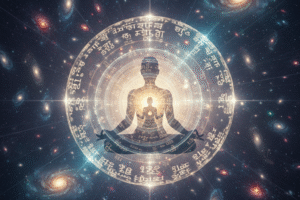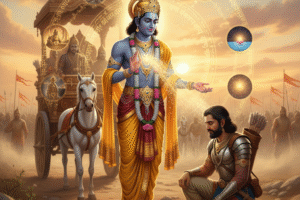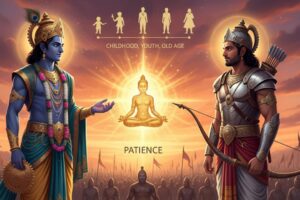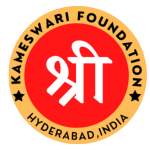
Prasthanatrayam & Prelude to Mahabharata War
- Posted by Sri Kameswari Foundation
- Date May 20, 2025
- Comments 0 comment
Prasthāna Trayam
The essence of life lies in knowing that one truth—knowing which,everything else becomes known.It is the experience of the Supreme Self,the cause of all causes.
The Vedas are the key to that knowledge,and the Upanishads—also known as Vedanta (Vedasya Antaḥ,the culmination of the Vedas)—are the key to experiencing it.
Thus,we know where to look and how to approach that knowledge.
In spite of the path being quite clear,we are unable to move even an inch closer to it—due to various historical and cultural reasons that are well known to us.
We have strayed so far from that path that taking a U-turn now seems almost impossible.
If we honestly introspect,how many of us are truly ready to take a U-turn and tread that path—despite all the difficulties?We have become so habituated to instant learning,understanding,and application that even a one-minute Instagram reel feels too long for us today.
So,what is the way out?
The Supreme Self,being fully aware of how His creation functions,has already provided solutions for every challenge that may arise.As Sanātanis,we need not worry.We just have to continue our quest for the solution.
The incarnation of the Supreme Self—Bhagavān Śrī Kṛṣṇa—imparted the essence of all knowledge and the path to experience it in just 700 ślokas across 18 chapters,now widely known as the ‘Śrīmad Bhagavad Gītā.’
Going further back,the knowledge of the Supreme Self was perceived and interpreted by our Ṛṣis in various ways,each suited to different purposes and contexts.
A popular classification of Vedāntic texts is the Prasthāna Trayam—the three foundational paths or sources of authority that a seeker can follow to realize communion with the Parabrahman.
Śruti Prasthānam:
This refers to the Upaniṣads,which are part of Śruti(revealed knowledge) and form the philosophical essence of the Vedas.These texts speak about the Universal Self (Ātman),about those who realize it and those who do not.
Primarily,10 Upaniṣads are considered major.They are typically in the form of dialogues—between a Guru and a disciple,or between friends.Being part of Śruti,these texts are not altered for simplification or interpretation,and traditionally,they must remain unchanged.
Nyāya Prasthānam:
This refers to the Brahma Sūtras,which organize and systematize Vedāntic teachings.These texts address complex philosophical issues and provide clarity on subtle topics that require deeper reasoning and analysis.
Smṛti Prasthānam:
Our current focus—the Bhagavad Gītā—belongs to this category.Here,the knowledge of Brahman is conveyed through ślokas that are easy to remember and often sung.Since the Gītā is a direct teaching of the Parabrahman—Śrī Kṛṣṇa,the Jagadguru—its clarity is unquestionable.
Coming to the Āchārya Paramparā (lineage of teachers) in the Sanātana tradition:
At the top stands Vyāsa Maharṣi,who classified the Vedas into four parts—Ṛgveda,Yajurveda, Sāmaveda,and Atharvaveda—and entrusted them to his four disciples for propagation.
Thus,Vyāsa Maharṣi played a pivotal role in the organization of Śruti Prasthāna.
But he also authored the Bhagavad Gītā(as part of the Mahābhārata),belonging to the Smṛti Prasthāna,and composed the Brahma Sūtras of the Nyāya Prasthāna—making his contribution foundational across all three.
Later,three great ācāryas offered authoritative commentaries (bhāṣyas) on all three texts of the Prasthāna Trayam:
Śrī Ādi Śaṅkarācārya – Advaita (non-dualism)
Śrī Rāmānujācārya – Viśiṣṭādvaita (qualified non-dualism)
Śrī Madhvācārya – Dvaita (dualism)
The Prelude to the Mahābhārata war
As we all know,the story of the Mahābhārata reveals the two sides of a coin—on one side are those who live by the essence of Dharma,and on the other are those who merely preach it without practicing it.
The Pāṇḍavas—the five sons of King Pāṇḍu:Yudhiṣṭhira (Dharmarāja),Bhīma,Arjuna,Nakula, and Sahadeva—stood firmly on the side of Dharma.They surrendered themselves to Bhagavān Śrī Kṛṣṇa and ultimately emerged victorious in the battle of Kurukṣetra.
The Kauravas—the hundred sons of King Dhṛtarāṣṭra,led by the ill-intentioned Dhṛtarāṣṭra himself,along with Duryodhana,Śakuni and Duḥśāsana—resorted to every form of adharma in their quest for the throne.In the end,they met with the punishment they deserved.
If you think that the war was simply a clash between two groups with differing ideologies,that would be a misunderstanding.Much was done to avoid the conflict—but ultimately,it became unavoidable.
Bhagavān Śrī Kṛṣṇa himself undertook a peace mission on behalf of the Pāṇḍavas,negotiating with the Kauravas.However,the Kauravas refused to share even a small portion of the kingdom with the Pāṇḍavas,who were its rightful heirs.As a result,war became the only remaining course.
While many debates exist around whether the true purpose of the peace mission was to provoke war or to prevent it,let us put them aside and continue towards understanding the timeless life lessons that Bhagavān Śrī Kṛṣṇa imparted to Arjuna.
So,let us now turn our attention to Kurukshetra—the battlefield where the great war of the Mahābhārata unfolded.
One striking feature of many of our revered texts is that the essence or outcome of the event is often hinted at in the very opening lines.
This is true even in the very first śloka of the Bhagavad Gītā.
It begins with the words: “Dharmakṣetre Kurukṣetre”—describing Kurukṣetra with the qualifier Dharmakṣetra,meaning “the field of Dharma.” This subtle yet powerful phrase suggests right from the outset that Dharma is destined to triumph in this sacred place.
At the beginning of the war,a total of 18 Akshauhinis of military forces were assembled.
An Akshauhini is an ancient Indian military formation,precisely defined in classical texts.Each Akshauhini consists of:
21,870 chariots
21,870 elephants
65,610 cavalry (horse-mounted warriors)
109,350 infantry
In this conflict,Duryodhana commanded 11 Akshauhinis,while Dharmaraja (Yudhishthira) led 7 Akshauhinis.
Dhritarashtra,being blind from birth,was unable to witness the events unfolding on the battlefield.Though he had some bad thoughts and intentions inside,he was still fortunate to be surrounded by noble souls like Vedavyasa Maharshi,Vidura and Sanjaya.
Through the blessings of Vedavyasa,Sanjaya was granted divine vision—a celestial gift that enabled him to perceive all that happened on the battlefield of Kurukshetra,not only in terms of physical events but also the mental and emotional states of the warriors involved.From the comfort of his chamber,Sanjaya explained to Dhritarashtra what was happening in the war.
This post covers the concepts related to the first episode. Please click on the “Meaning of Shlokas 1-25” link in the Śrīmadbhagavadgītā Tattvamu home page to read the meaning,that has been explained in Episode-1.
You can also listen to this in Telugu from our Āchārya,Dr. Jammalamadaka Suryanārāyaṇa garu,by clicking the video below.
You may also like

Pratyabhijna,The Deeper Meaning of Antaha,Atma Tattvam

Ch-2|Meaning of Shlokas 15-17

